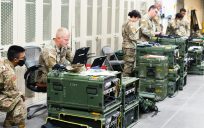This blog post is an excerpt from GovLoop’s recent guide “Analytics in Action: How Government Tackles Critical Issues With Data.” In this guide, we share firsthand accounts from government employees at all levels who are using analytics to identify critical issues and find solutions. Download the full guide here.
The Veterans Affairs Department is the largest integrated health care system in the United States. Through its Veterans Health Administration, the VA provides care at 1,245 health care facilities, including 170 VA Medical Centers and 1,065 outpatient sites. VHA serves more than 9 million enrolled veterans per year.
To learn how the agency manages its responsibilities with data analytics, GovLoop spoke with Dr. Peter Almenoff, Chief Improvement and Analytics Officer at the Veterans Affairs Department.
GovLoop: What issues is your organization trying to tackle?
Almenoff: VA care providers are trying to ensure that we have safe, effective, efficient and sustainable high-level care. [Our] areas of specific focus align to the VA Secretary priorities, along with what we look at in the private sector. For the Secretary, his priorities include eliminating suicide among veterans, enabling more choice for veterans regarding where they seek their care, and then regaining the trust [of] veterans and the nation by publishing measures of quality, access, patient experience, including comparisons with the private sector when those are available.
GovLoop: How are you using data and analytics to address those issues?
Almenoff: We use data for the leadership and for staff at all levels to identify gaps in opportunities. We [also] do education and in-service [training] for our stakeholders on our tools — interpreting the findings [and] connecting the dots to make sustainable and systematic change. We try to give them internal and external benchmarks for quality and efficiency that integrate into analytics to allow comparisons of performance within the VA and community partners. We use Statistical Process Control methods to establish trigger systems for health outcomes, like productivity [and] access. We do that in both acute care and outpatient care. The idea behind that is to really detect deviations in care processes to see whether we have scheduling practices that we need to address, [and] staffing and productivity issues.
We have some real-time process control systems that look at things like outcomes, patient safety and hospital complications. On a daily basis, VA can look across the country with a trigger system [and] be able to identify those issues and address them.
We can’t predict the weather, so these systems are designed to detect signals of abnormality and then the facility’s first job is to see whether it’s explainable or not. If not, then they have to look at their processes to see what the issues are.
We also use a whole series of visual analytics. We have something called the goal-setting calculator, which is [a] tool that allows medical centers to set their goals for improvement for the year. Each medical center can set their goals. It’s designed [as] a prediction model, so it predicts where they’ll be in six months and where the system is going. It shows them the areas of opportunity and allows them to set their goals locally so they can continue to move in a good direction.
GovLoop: Can you share a time when your organization used analytics to drive better decision-making?
Almenoff: We build early warning systems and risk stratification systems to identify areas of risk in performance. We [also] have an improvement side that will target those areas and work with them to improve. We can identify what we consider high-risk areas for facilities to work on.
GovLoop: What did you learn and what were the outcomes?
Almenoff: In 2016, we looked at what’s called an effect size. This is a way to see whether medical centers are better than they were a year earlier. Last year, 82 percent of our VA [medical centers] performed better than their prior year. What contributed to this was leadership engagement at all levels of the organization.
GovLoop: Can you share tips on how you got the data you needed and decided what tools/ techniques to use?
Almenoff: The secret is understanding what’s important and what’s valid. Most of our staff has at least 10 or [more] years working with the VA dataset. So [the] first piece is you have to have somebody with credibility and understanding of [the] systems.
GovLoop: How are you creating a culture for analytics at your agency?
Almenoff: The first thing we do is develop the analytic projects that are necessary [by doing] an assessment of the needs. We’ll look both internally and externally. We are very responsive to VA [central offices’] senior leadership and program offices [and] to facilities and regions because they’re really the stakeholders. We’re always looking for field input. When they feel like they own it —or are part of it — they buy in a lot quicker. You get a lot of buy-in when you’re responsive to your clients [and] partners.
We provide a lot of educational sessions — both for the leadership and for field [workers]. You can’t make this purely a black box; you have to try to make it as understandable to people as possible. [Also] visual analytics is key. If you don’t have it in a format that they understand, it just doesn’t work.
GovLoop: What do you hope to do with data and analytics in the near term and long term that you cannot do today?
Almenoff: Our hope is to get to more real-time. We do something called the G-chart, which is the geometric charts. So every day across the country, you can look at things like outcomes, patient safety issues and hospital complications. That’s our first test, and it’s been very successful. It’s a balance; you can’t just give everything to everybody every day.
That’s one of our hopes for the future: to get them more real-time. In addition, try to become more predictive. The idea is to build more predictive tools in more areas that make them seamless within our system. [It’s] not just about building them, but [finding] solutions. We need to try to find the early signs of facilities that are not performing where they need to.





Leave a Reply
You must be logged in to post a comment.